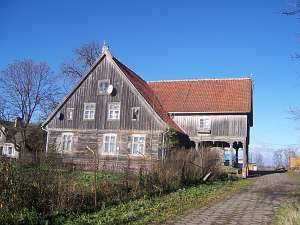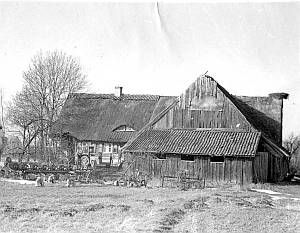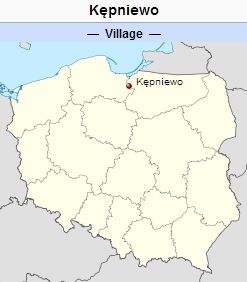Kampenau (Warmian-Masurian Voivodeship, Poland)

Source: Catalogue of Monuments of Dutch Colonization in Poland website.

Source: Catalogue of Monuments of Dutch Colonization in Poland website.
Kampenau (also known as Campenau; now known as Kępniewo; coordinates: 54.0176, 19.3573 [54° 1′ 3″ N, 19° 21′ 26″ E]; population in 1905, 449; in 2013, 370) is located approximately 16.5 kilometers (10 miles) south of Elbląg (Elbing), 20 km. (12 miles) east of Malbork (Marienburg), and 27 km. (17 miles) south-east of Nowy Dwór Gdański (Tiegenhof).
Kampenau was founded by the Teutonic Knights in 1337. Initially Kampenau was located directly by the western shore of Lake Drużno. Later, in the 16th century, the shoreline receded and a marsh was formed. Eventually a wet-ground forest developed. In 1558, the forest located to the east of Kampenau was cleared and timber was used to reinforce the flood bank. In ca. 1590, the cleared area was settled by Dutch settlers, primarily Mennonites, under the emphyteutic contract, and they began to develop the area.
Until 1772 Kampenau was located in what was known as Royal Prussia (also known as Polish Prussia) in the Kingdom of Poland. The First Partition of Poland in 1772 resulted in the creation of a new province in 1773, called West Prussia, in which Kampenau was located. Kampenau was situated in the district (Kreis) of Marienburg until the end of World War I, when it came under the jurisdiction of the German province of East Prussia. At the outbreak of World War II in 1939, it came under the control of Nazi Germany. In February 1945 it was occupied by Soviet forces and eventually returned to Poland. In 2012 it was a village in the administrative district of Gmina Markusy, within Elbląg County, Warmian-Masurian Voivodeship.
The 1776 Prussian census lists 22 Mennonite families in Kampenau with the following surnames: Albrecht, Dau, Dick, Dircksen, Friesen, Froes, Funck, Goertzen, Jantzen, Kleewer, Martens, Nickel, Pauls, Penner, Philipsen, Quirling, and Siebert. In 1820, the village had 410 residents, including 98 Mennonites.
Mennonites who were residents of Kampenau were members of the Thiensdorf-Markushof Mennonite Church.
The Mennonite cemetery is located ca. 150 m to the west of the Zwierzno - Stare Dolno road, on the northern side of a birch alley. It was established at the end of the 18th century and has a rectangular layout. There are 140 graves with gravestones of the following families: Boerzen, Froehlich, Gringel, Grunau, Heinrichs,Jarke, Jansen, Penner, Riesen, and Unger. The oldest preserved gravestone dates from 1796.
Bibliography
Stowarzyszenie Konserwatorów Zabytków. "Kępniewo." Catalogue of Monuments of Dutch Colonization in Poland. 2005. Web. 16 February 2013. http://holland.org.pl/art.php?kat=obiekt&id=354&lang=en.
Wikipedia. "Kępniewo." Web. 16 February 2013. http://en.wikipedia.org/wiki/Kępniewo.
Wolf, Hans-Jürgen. "Familienforschung in Westpreußen." Web. 16 February 2013. http://www.westpreussen.de/pages/forschungshilfen/ortsverzeichnis/details.php?ID=2887.
Maps
Map:Kępniewo, Warmian-Masurian Voivodeship, Poland
| Author(s) | Richard D Thiessen |
|---|---|
| Date Published | February 2013 |
Cite This Article
MLA style
Thiessen, Richard D. "Kampenau (Warmian-Masurian Voivodeship, Poland)." Global Anabaptist Mennonite Encyclopedia Online. February 2013. Web. 21 Nov 2024. https://gameo.org/index.php?title=Kampenau_(Warmian-Masurian_Voivodeship,_Poland)&oldid=168599.
APA style
Thiessen, Richard D. (February 2013). Kampenau (Warmian-Masurian Voivodeship, Poland). Global Anabaptist Mennonite Encyclopedia Online. Retrieved 21 November 2024, from https://gameo.org/index.php?title=Kampenau_(Warmian-Masurian_Voivodeship,_Poland)&oldid=168599.
©1996-2024 by the Global Anabaptist Mennonite Encyclopedia Online. All rights reserved.
